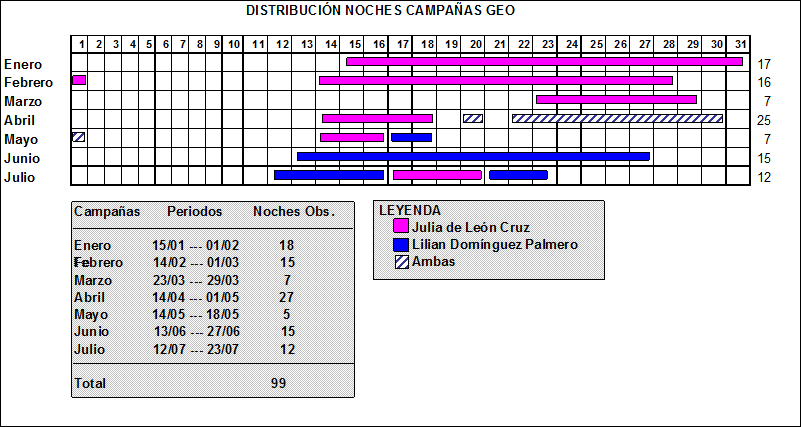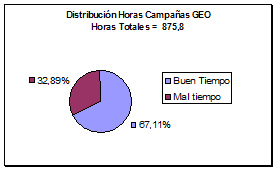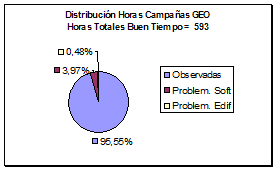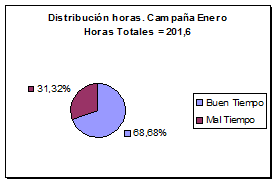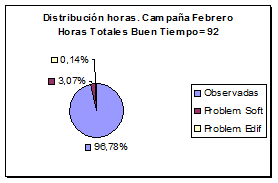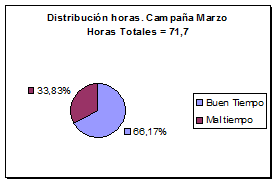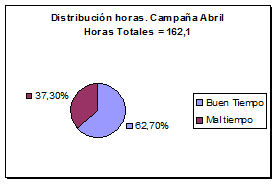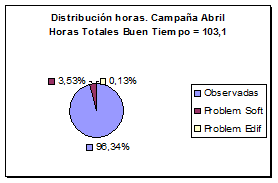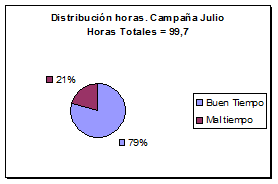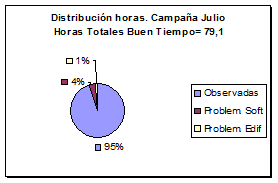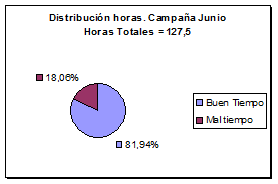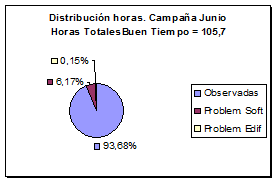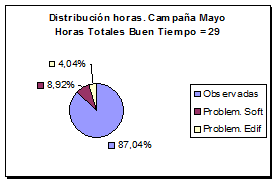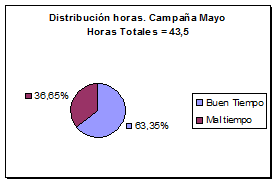Reports 2001Space Debris Proyect
The document here presented consists of a short report of the achievement of the Geostationary Orbit Object Survey, carried out from January to July 2001 at the Optical Ground Station, under sub-contract No. 11914/96 with AIUB, to contract No. 11914/96/D/IM with ESOC, ESA. Some statistics about time distribution and seeing conditions are explained. IntroductionThis document briefly describes how the Geostationary Orbit Object Survey has been carried out during the period of time that ranges from January to July 2001 at the Optical Ground Station (OGS), under sub-contract No. 11914/96 with AIUB, to contract No. 11914/96/D/IM with ESOC, ESA. Here we present some statistics about the site atmospheric conditions (seeing), the distribution of the observation nights and the different technical problems found during the achievement of the observation campaigns.
The campaingsThe Geostationary Orbit Object Survey has been distributed over 7 campaigns, selected, among other criteria, to coincide as much as possible with New Moon to avoid scattered light. Generally speaking, we have not lost too many nights due to bad weather conditions or technical problems, so it has been a good observational period. In the middle of April campaign we incorporated another telescope operator, so we increased work efficiency and diminished the risk of loosing an observation night because of illnesses or accidents. Figure 1 shows a graphical representation of the distribution of the observation nights over the whole period. The number that appears at the end of each row of the table indicates the number of observation nights each month. Here we did not take into account those nights in which the operator was not at the observatory (there would be different reasons for that circumstance, such as lengthy bad weather conditions and several technical problems). Furthermore, it can also be seen at Figure 1 that there is a period of time in which the two operators coincide. Although that was a training period, we compute the observation nights each operator stays at the telescope and add them. Due to the excellent atmospheric conditions (specially during January and February campaigns) the GEO Campaign has been accomplished within 6-7 months and the total number of observation nights slightly surpasses the number of nights signed at the contract (90). That is quite a significant fact to have in mind. Everything has worked properly.
Figure 1. Distribution of the observation nights during the Geostationary Orbit Objects Survey campaigns.
DISTRIBUTION OF THE OBSERVATION TIME
Figure 2. Distribution of the observation time during the complete period of GEO campaigns.
Figure 3. Distribution of the observation time within each campaign.
If we make a separate pie chart for each campaign (Figure 3) we will see a similar distribution for the majority of the campaigns, excepting maybe May campaign that, with only 5 observation nights, had to deal with a cloudy sky most of the time and with two UPS crashes. This obviously led to a maximum in the percentages of lost time.
SEEING CONDITIONSWe have measured seeing values during the observational period of the Geostationary Orbit Object Survey. These measurements include atmospheric seeing and perturbations introduced by dome-telescope system. The technique employed to obtain these values is the following. In order to focus the telescope at the beginning of a typical observation night we normally take an unbinned image of 10 sec. Using the IRAF imexam task, we observe radial profiles and note down values of the FWHM of different stars in the field of view. Once we find the appropriate value of the focus, we take the maximum and the minimum FWHM and get the average value. Finally we multiply this value with the CCD resolution : 0.62 arcsecs / pixel.
Figure 5. Histogram of the seeing values of the GEO campaign. The great sky quality of the Observatorio del Teide can be seen at Figure 5. It shows the distribution of seeing values over the 88 nights that form GEO campaign. The histogram presents its peak near 1.0 asrcsecs. This is comparable to the values registered at the IAC 80 telescope from 1/Oct/98 to 9/May/99 (see http://www.iac.es/telescopes/ten.html and click on IAC80 and seeing for further information ). The dome of the Optical Ground Station is quite big and its contribution to the perturbations of the overall system is not negligible. Some simulations and the experience gained in other telescopes led to a typical value of 0.5 arcsecs, which has been conveniently subtracted in order to do the histogram.
Figure 6. Data of the histogram. The standard deviation is slightly below 0.5 arcseconds, probably due to the fact that the sample is not large enough to do precise statistics.
CONCLUSIONS:The main conclusions derived from GEO contract are: • No significant problems appeared during the execution of the Level-1 telescope control software or the on-line data processing system, and the ones that appeared were easily solved. • Control systems related to the building itself had also an excellent behaviour. • Excellent weather conditions contributed to a great extent to increase the number of “operational” observation nights and the great sky quality of the Observatorio del Teide was also decisive for the achievement of the whole project. • After having seen the results of the GEO campaign, with concern to the distribution of the observation time and the seeing conditions we can conclude that it has undoubtedly been a good campaign. The Geostationary Orbit Object Survey has been carried out as it was planned: all the systems have worked properly and the two operators have done their work efficiently.
|
|---|
